Introduction
If we start making Kadaknath keeping as a business, then it does not give any returns until 6 months of age. The cost of young chicks over 100 rupees so if you buy 100 chicks then it will cost 100×100= 10,000 rupees. Plus rearing cost and housing will cost you above 50,000 rupees, till it starts giving returns in the form of eggs. But, if we introduce Barbari Goat keeping with this then returns are immediate in the form of milk.
If we keep 5 adult goat then it will cost about 40,000 and its feeding and rearing
I am writing about Barbari goat because farmers have already asked me that whether they can couple Kadaknath keeping with goat keeping. To my mind, Barbari goat in northern India is the most suitable goat for early returns.

Why only Barbari goat?
- The Barbari goat is a small size goat weight is about 30-35 kg female, 40 kg male.
- There are many breeds of the goat but broadly you can divide it into two. The big goat weighing over 60kg and the Barbari goat which is weighing over 30 kg.
- Because of its size, its housing is easy. The bigger goat requires 30 square feet of area whereas the Barbari goat requires 15 square feet of area.
- The Barbari goat is a prolific breeder it gives 4 kids in one year time. Thus its multiplication rate is 1:4, other goats multiplied with a rate of 1:2.5
- These goats mature, within a year and that is in 11 to 10 months of age.
- Its lactation length is equal to lactation length of Sirohi goat that is 100 days.
- Barbari goat gives daily 1 kg of milk. Whereas Sirohi also gives 1kg per day.
- The Sirohi goat matures in 18 months of time and it gives only one kid per year.
Barbari goat is completely stall-fed it does not need browsing. Sirohi goat can also be maintained in stall feeding it loves browsing in the wild. Goats are sold 300 rupees per kg, So 30kg Barbari goat will cost 9,000 whereas 60 kg Sirohi goat will cost around 18,000, so the initial investment in Barbari goat is low.
Best Suitable Places for Barbari Goat
Barbari goat is suitable in between Ganga and Yamuna it needs green plants, to browse and need some humidity also. The Sirohi goat is native of Ajmer and it does not tolerate high humidity and wet climate. Whereas the Barbari goat can live in a
In northern India, this Sirohi and Barbari goat is suitable for every type of climate otherwise other breeds of goat-like Jamuna Pari and Beagle are homesick they cannot be shifted from their native place. Barbari goat does not thrive well in a cold and humid climate, so it’s true for the Sirohi goats. In the Tarai region of Uttar Pradesh Barbari goat in winter does not survive.
Characteristics & Full Breed Information of Barbari Goat

Barbari goat is a small-sized meat goat breed mostly found in the north-western arid and semi-arid regions of India. It is one of the 23 registered goat breeds in India. Found in Agra, Etawah, Uttar Pradesh, Gujarat and Bharatpur district of Rajasthan. As well as in Jhelum and Sargodha districts in Punjab Province, Pakistan. Basically, the Barbari goat originated in Berbera, Somalia of East Africa.
Probably this breed derives its name from its origin place Berbera. The way of Barbari goat and it’s a migration to India is unknown. But probably the traders of the medieval period might have brought them to India through sea and land routes during their business entourage. Agra, Etah and Etawah are the breeding tract of Barbari goat in India. Today the breed is well adapted for Indian conditions and gaining popularity as meat goats.
Physical Characteristics of Barbari Goat


Barbari goat has unique characteristics. It’s a pretty small animal with a medium-sized compact body. They are alert and attractive. And have bulging eyes, because of their quite prominent orbital bone. Ears are short, tubular, almost double, with the slit opening in front, erect, directed upward and outward. Bucks have a large thick beard.
Barbari does have well-set udder with conical teats. Both buck and doe have twisted horns, directed upward and backwards, are medium in length. Barbari goat has a wide variation in coat colour. But usually white with small light brown patches is the most common colour. On an average, adult barbari bucks weight about 37.85 kg and does about 22.56 kg.
Uses
Babari Goat is mainly raised for Meat. But it is also pretty good at milking. This goat breed is very suitable for commercial meat goat farming business.
Special considerations
Barbari goats are well known for their good meat qualities and also for triple kidding. Both bucks and does mature early and are resistant to common goat diseases. Barbari goat has a good feed to meat conversion ratio. It is highly suited for rearing under restrained and stall-fed systems. Along with being good milk producers, the barbari goats are also a good milker and is highly prolific. In most cases, the males are castrated at a very early age, when they are raised for commercial meat production. Review full breed profile of barbari goat in the chart below.
Barbari Goat Profile
Breed name
Other names
Breed purpose
Breed size
Weight
-Buck
-Doe
Horns
Climate tolerance
Good for stall-fed
Rarity
Barbari
None
Mainly raised for meat production
Small
About 37.85 kg.
About 22.56 kg.
Yes
Heat
Different colour variations. But white will small light brown patches is the most common.
Yes
Common
Specialities and Habitat of Barbari Goat
Origin
They are from Barbara in Somalia. They are thriving well in Uttar Pradesh, Haryana and Punjab. As this breed is stall-fed it can be raised in the tropics and subtropic region. At 20°C temperature and 69% humidity they do
The temperate zone has milk goat and the tropical goat has the meat goat. The length of the year is an indication of the area of the goat. The tropical goat has log years (Jamunapari) because the blood circulation in the year helps in the dissipation of heat. The temperate goat has short years(Sannen or Alpine) this conserves heat.
Milk Production
They produce 100-litre milk in 150-day lactation they are hardy and disease resistant. Their kid is allowed to suck milk 5 times a day. The kids require 10 to 20 % milk of their body weight. So for two kids milk produced by doe is sufficient. The milk of doe increase as the lactation process. It is a
History
The goat is first to be domesticated. The domestication goats started before 12,000 BC when the man was leading a nomadic life. The coat followed man where ever he went in food and shelter to avoid the harsh climatic condition. Thus a variety of goats are found all over the world. You can find a goat in no bound area to the hot desert area. Human and goats have been migrating in these areas, in search of food and avoiding harsh climatic conditions. But a goat surviving in the temperate region will not survive in the tropical
Disease & Parasites
The goat is very susceptible
The metabolic rate of the tropical goat is low so its milk production is not possible. It is a meat-type goat, like Sirhoi Goat. In India, its hot climate most of the goat are meat type. The big meat goat produces milk but it is hardly 2 kg and lactation length is 90 days.
Whereas this goat though small in size but produces over 6 kg milk per day it is kid once a year and the lactation length is long 250 days. The dairy goat is stall-fed whereas the meat goat of the tropical area is grazing type. But the meat goat of the tropic and subtropical area the Barbari is stall-fed. So it can be raised on the hydroponic grow fodder within urban area without land and use of fertilizers. The details of hydroponic and growing other fodder crop are given below.
Reproduction in Barbari Goat
Barbari goat is prolific breeder they breed very fast. This goat mature at months of age and start exhibiting heat or estrus. The estrus length is 21 days they are polycyclic. So in a breeding season, they come in estrus sometimes the first heat should be skipped. At first heat after puberty or after kidding they should not be mated. Once served or mated they fall pregnant and after 150 days or 5
The housing of Barbari Goat
Barbari goat is half of the size of a big goat. Big goat male weigh 100 kg and need 30 square areas where the Barbari goat needs only 15 square feet and coverage area and the rest open-faced ahead, the length of the shed should be east-west. If you are starting with 5 pregnant goats then you need 15×5= 75 square feet land. If you extend the farm then accordingly you can extend the goat farm.
The raised area is for the stall feeding and for confining goats in adverse climatic condition. The floor for the goat in the raised area is slatted so the faecal matter will fall down. And the goats will be free from internal parasites. Above all the goat will be protected from rains and water lodging on the ground.
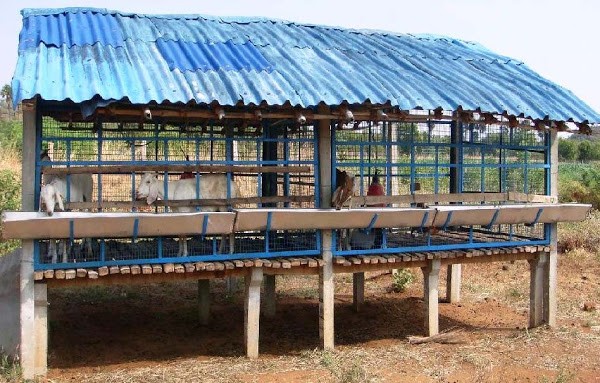
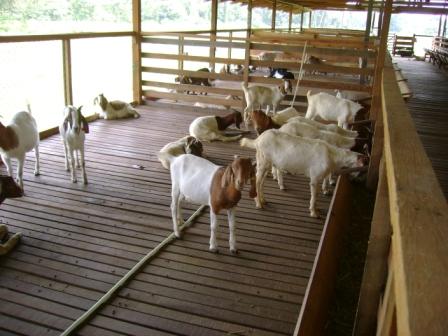
The climate variables like temperature humidity and rai nfall at Mathura Uttar Pradesh is shown below.
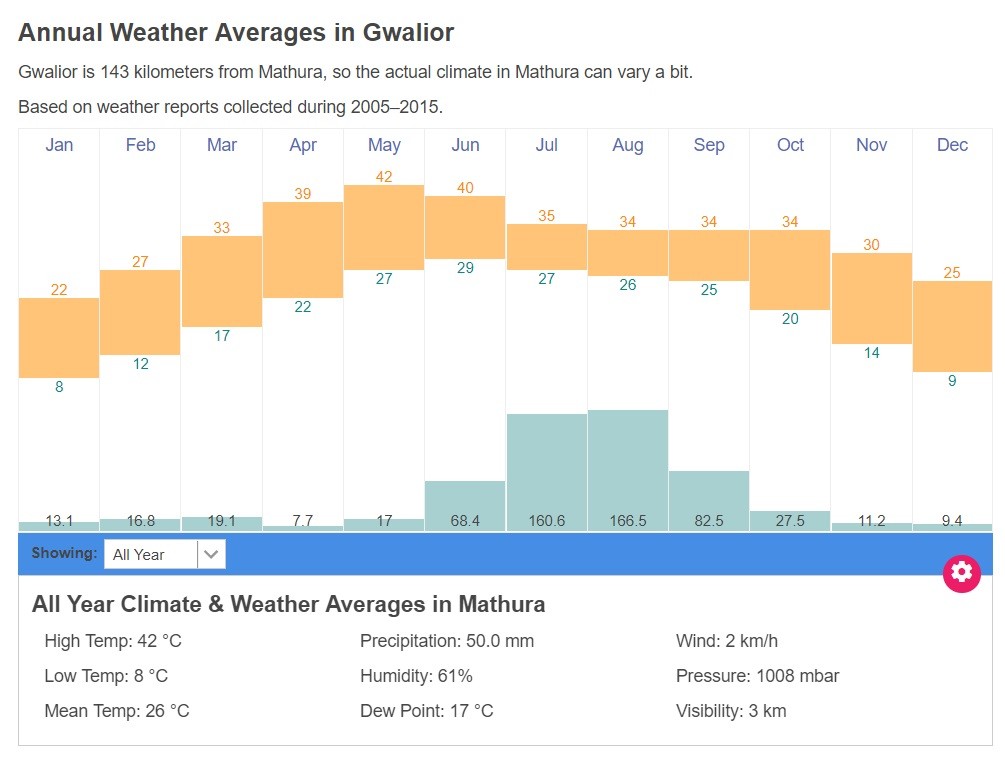
Source: www.timeanddate.com
Once kids are born they can be housed separately. What we suggest is that these kids be housed in dog cages for better feeding and care. Once the buck is purchased it housed separately. The buck will be purchased 2 months after the kidding. It should be housed in 10 square house. If you are not purchasing pregnant does and purchasing the 9-month-old female then they can be housed in the same house. There should be a feed store, medicine room, and a place for an office.
The goat should be protected from rain and excessive heat and cold. They like a dry place with 20°C to 35°C. They are well suited for stall feeding. Rains with wind make sick. High humidity will make them sick so in July and August month you need extra care.
Feeding of Barbari goat
As mentioned in the title these goats can be raised hydro phonic fodder so the concentrate feeding will be less. Only in growth, pregnancy, and lactation, you need to feed 200 to 300 gm of feed. The composition of the feed is given in the table.
| Composition | Quantity in % |
| Maize | 50% |
| Gram | 20% |
| Soya bean or Cottonseed | 20% |
| Wheat bran (Choker) | 8% |
| Mineral mixture | 2% |
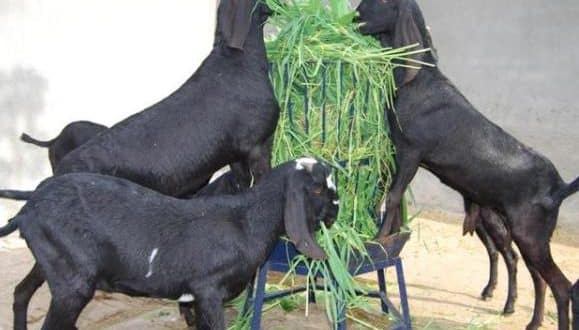
Place salt lick and freshwater, in winters, give warm water. Do not feed excessive grains it will cause acidity and indigestion and can cause death. The kids should be given colostrum just after birth. Kid need milk 10 to 20% of their body weight per day do not overfeed.
Goat Vaccination
In vaccinating the goat we inject the killed microorganism or weak organism in a healthy goat. It takes 3 week or 21 days to develop antibodies (a protein molecule to kill the disease-causing microorganism, of which killed or weak organism has been injected) the killed or week organism elicits or evokes a particular gene to produce protein the antibody. The young goat till one month has no capability to produce antibody and antibodies are secreted in first milk then colostrum provided the mother is vaccinated. To ensure the pregnancy vaccination.
If the mother is vaccinated then you can vaccinate the kid at 2 month age otherwise vaccinate at 1 month of age. The best thing is that you can purchase goats from an authentic source. But the FMD vaccination is needed to be done 4 times a year this is Indian immunological recommendation follow the recommendation given on the particular vaccine. In the case of the PPR vaccine, you need to give once in 3 years. HS and BQ vaccine is given once in a year. There are combined HS, BQ and FMD vaccine never use that because you can not vaccinate a goat before the due date. Keep the proper record of a vaccinated goat. The list of vaccination is given below. Do not vaccinate in early pregnancy or at service or breeding.
| Vaccine Name | Age | Duration |
| Anthrax | 6 Months | Yearly |
| HS | 6 Months | Yearly |
| BQ | 6Months | Yearly |
| PPR | 3 Months | After 3 Years |
| FMD | 8 Weeks | Four times in a Year |
| POX | 4 Weeks | Yearly |
| CCPP | 4 Weeks | Yearly |
| Enterotoxemia | 4 Weeks | Yearly |
HS – Hemorrhagic Septicemia
BQ – Black Quarter
FMD – Foot and Mouth Diseases
CCPP – Contagious Caprine Pleuropneumoniae
PPR – Peste des Petits Ruminants
Things to keep in mind before and after vaccination
All the goat should be tagged with the identification number and the record should be maintained. If the goat is purchased from the authentic farm then take vaccination record. You can not vaccinate the vaccinated goat before the due date because it will have an adverse effect on their immunity.
For example, the PPR vaccination is done every 3 years and if you do it after a year then the antibodies already in blood will react with the antigen, that is an organism and will be destroyed thus the outbreak of the disease. So follow the due date. If vaccination is delayed then it will cause no harm. HS, BQ and FMD vaccine is combined and for the first time the combined vaccination would be done but the FMD vaccination scheduled after six months so follow that. The BQ and HS vaccination be done yearly.
The FMD, PPR and Pox are viral diseases, so no antibiotic is effective but the bacterial disease like HS, BQ and anthrax can be treated by the antibiotic.
De-Worming of Goat
Goats are very susceptible to parasite the grazing goat shed faeces outside along with the grazing route but the stall-fed Barbari goat should house them at height on slatted floor. This will save from infection. The lung, stomach and intestinal worm need femindazole (Panacur) in pregnancy the kid every month and in adult every 3 months especially before and after rain. For fluke the liver worm and tapeworm give albendazole. For external parasite in shed use but-ox. And for external parasite on goat use tactic. Consult your veterinarian. Get the faecal sample examined.
For Internal Parasites
Internal parasite like lung, stomach, intestinal worm has a life cycle of 21 days. That is to say that they lay thousands of eggs which hatch in 21 days. The de-wormer given kills only the adult worms, not the eggs. So give de-wormer once then after 21 days then after 6 months. some de-wormer like Ivermectin remain active for 28 days so it is given in every six months.
The goats on the slatted floor suffer less of the parasite. In the snow-covered area and the hot desert at 45°, kills parasites. The grazing goat suffers more of a parasite than a stall-fed goat. The kiddies of stomach worms so they should be de-wormed every month. I am giving the common de-wormer.
| Vaccine Name | Dose | Duration | Affected body part |
| Femindazol | 5 mg | 3 Months | Lungs, Tape, Stomach and Intestinal Tract |
| Oxyclozanide | 15 mg | 6 Months | Liver |
| Ivermectin | 1 ml/25kg | Every 6 months | External body |
For an external parasite, the application of Botox should be done every 14 days in shed 4 ml/litre. For animal body every week Taktic 4 ml/litre for four weeks. Get the faecal sample examined by a veterinarian.
Enterotoxemia in Goat
Also known as pulpy kidney disease caused by Clostridium perfringens type D this is caused by overeating.
Symptoms of Enterotoxemia
- Excessive vocalization
- Depression
- Teeth grinding
- Convulsing
- Abdominal pain
- Lyinginging on ground
Treatment
- B1 injection
- Penicillin
- Treatment for blot
- Treatment for abdominal pain
Its vaccine is combined with tit anus vaccine. To save kid vaccinate pregnant doe one month before parturition.
Peste des Pestits ruminants (PPR)
It is a viral contagious disease it causes great loss vaccination is effective for 3 years. Do not vaccinate before 3 years. About vaccination verify before purchase. Keep a record of vaccination symptoms.
- Depression
- Fever discharge from mouth, nose, eyes and sore mouth coughing and diarrhoea and death.
FMD or Foot and Mouth Disease
- Fever sore throat blister in mouth sore soul
- Irritability in infants
- Abortion if exist for a week
- Treatment is symptomatic
Purchase of goat
Make it a point to open a breeder farm for Barbari goat. So buy the best goat from the reputed farm. Barbari goat is a small goat male weighs 35 and female 25 kg. Roughly they cost 350 rs/kg so 40 kg animal will cost 40×350=14000 rupees, so for a unit of 5 goats, it will cost 40,000. Buy goat in February month when the temperature is rising. Do not buy a goat in rains and in cold month do not buy so many goats at a time.
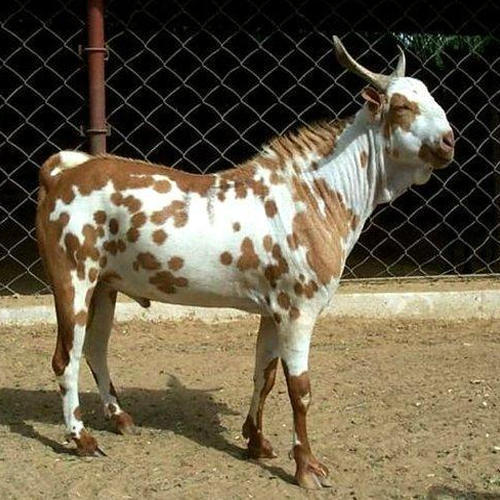
Most welcome sir
Good day sir , first time post delivery one of my goat got week and is not improving in health even though active and eating enough.....now almost two and half month passed what extra supplements are required to bring back her in good shape ??? Weather in the of food or injectable medicine
Kindly do suggest about it.